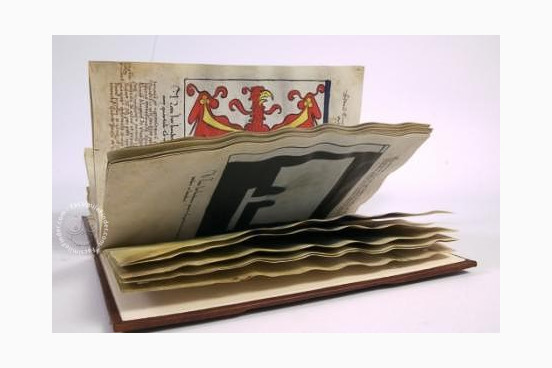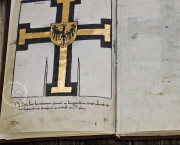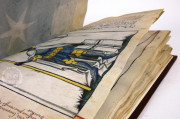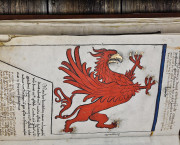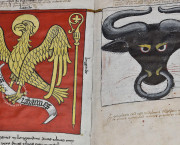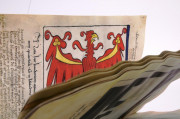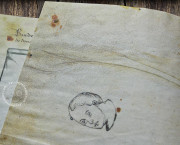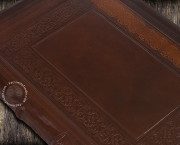Blazons of the Prussians is an illuminated manuscript dated March 29, 1448, and signed by its principal scribe, Jan Długosz. It features illustrations by Stanisław Durink of fifty-six banners captured from the Teutonic Order after their defeat by Polish-Lithuanian forces at the Battles of Grunwald and Koronowo in 1410 and the Battle of Nakło in 1431. Each banner is presented alongside a Latin description. The work is a visual record of medieval warfare and an expression of Polish national identity. It offers linguistic and cultural insight, with its Latinized forms of German place names.
This manuscript was created as a safeguard against the potential destruction or loss of the actual banners, ensuring that the Polish nation would preserve the memory of its triumph in what is considered the most significant battle of the Middle Ages.
The Largest Battle of the Middle Ages
In Anno Domini 1410, on July 15 (the feast day of the Dispersion of the Apostles), the combined forces of the Kingdom of Poland and Grand Duchy of Lithuania decisively defeated the Order of Brothers of the German House of Saint Mary in Jerusalem. This conflict, commonly known as the Battle of Grunwald (or the First Battle of Tannenberg), stands as the largest military engagement of the medieval period. Though historians continue to debate the precise numbers involved, the battle undoubtedly engaged tens of thousands of knights, including the renowned Zawisza of Garbów, the Black Knight.
Despite King Władysław II Jagiełło's failure to immediately capitalize on this overwhelming victory, the battle permanently diminished the Teutonic Order's military power. The Order suffered catastrophic losses, including approximately 200 of its 250 brothers and the Grand Master himself, Ulrich von Jungingen, with many others taken captive.
Precious Banners
Among the numerous spoils of war, the Polish army captured Teutonic banners, crucial symbols in medieval warfare. These banners served as rallying points and directional guides for military units during battle. Bearing a banner represented great honor, while capturing an enemy's banner signified significant achievement. The fall of a banner often presaged defeat and could devastate troop morale, as nearly occurred when Teutonic forces almost seized the great banner of the Cracow District during the battle.
Military units entered battle under banners displaying the coat of arms or emblem of their sponsoring town, bishopric, or noble house. Elite units, including that of the Black Knight, fought under specialized banners reserved for distinguished warriors.
In total, Polish knights captured over 51 banners from the Teutonic knights, their Prussian vassals, guests, and allies. Some were deposited in Vilnius Cathedral, where they were likely destroyed in a fire in 1530. The remaining 51 were placed as votive offerings in St. Stanisław's Chapel in Cracow Cathedral, later joined by additional captured banners: one from Krone (October 10, 1410) and four from Nakel (September 13, 1431). Though these banners remained displayed for 38 years, the identity of many became confused over time.
In 1447, during the coronation of Casimir IV Jagiellon, a Teutonic diplomatic mission visited Cracow. Jan Długosz likely used this opportunity to inquire about the banners, as the Teutonic envoys could still recognize the coats of arms. With their assistance, Długosz documented the banners and commissioned colored illustrations to preserve their images for posterity.
One of a Kind Manuscript
Blazons of the Prussians was created in three distinct phases. First, artist Stanisław Durink created images of the banners on March 29, 1448, including measurements and signatures. The painter initially planned to place one image per leaf but eventually placed banners on both sides of leaves from pages 9 to 32 before reverting to his original format. The banners were depicted with vertical flagstaffs, as they appeared in the chapel, with meticulous attention to detail.
In the second phase, Długosz himself likely added brief descriptions identifying the owner and leader of each regiment. The commentary demonstrates greater knowledge of Teutonic commanders than of bishopric and municipal banner leaders, suggesting a Teutonic informant.
The third phase involved supplementary annotations written in lighter ink by another hand, compiled over many years after 1457 based on information from Teutonic knights. The author of these additions remains uncertain.
The manuscript was initially bound with iron corner pieces, as evidenced by rust marks on the parchment. Its current binding, of stamped dark brown leather from the 16th century, was carefully restored in the 20th century. The codex consists of five sections of parchment sheets, totaling 47 surviving pages of an original 50.
Długosz donated the manuscript to the University of Cracow, as indicated by his inscription on the first page. In the 16th century, the codex mysteriously transferred to the Library of the Cracow Chapter. It was seized by German authorities in May 1940 and gifted to Malbork. After the war, it was discovered in a London antique bookstore, purchased by the Polish embassy, and returned to Poland. Today, it resides in the Jagiellonian University Library, fulfilling its author's wishes.
The Fate of the Banners
The actual banners remained on display in St. Stanisław's Chapel until at least the early 17th century. They were documented by Bartosz Paprocki in the 16th century, and according to the Guide to Cracow Churches, they remained there until 1603. Their subsequent fate remains unknown, though they likely did not survive the Swedish Deluge.
A record suggests that in 1797, Teutonic banners were transported to the Military Museum in Vienna (the headquarters of the Teutonic Order), but which specific banners these were remains unclear. In 1900, copies of 50 banners were created, with additional reconstructions made between 1937-1939. Some of these copies survived World War II, and in 1962, seven more standards were reproduced. The remaining 36 banners were recently reconstructed at the Fabric Conservation Workshop of the Wawel Royal Castle, with restoration completed in October 2009—fulfilling Długosz's original intention that his documentation would enable future reconstruction of the deteriorating banners.
Historical Significance
The manuscript's historical value cannot be overstated. It serves as a unique catalog of medieval banners, providing insights into town and commandry emblems, Teutonic military organization, and troop mobilization methods. The document reveals that the first regiment from a commandry was led by the commander, the second by the vice-commander, and some commandries provided third regiments when necessary. This explains the presence of multiple similar banners from the same regions, with only slight variations in colors or details.
The manuscript stands as a testament to both medieval military history and the foresight of its creator in preserving this visual record of a pivotal moment in European history.
We have 1 facsimile edition of the manuscript "Blazons of the Prussians": Banderia Prutenorum facsimile edition, published by Orbis Pictus, 2009
Request Info / Price
